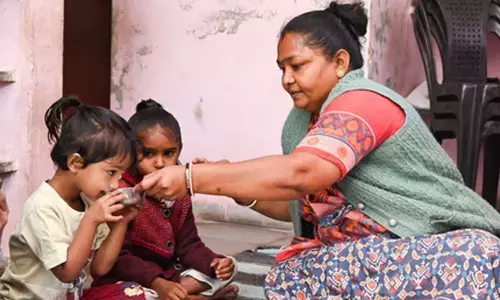NABARD red flags low milk production, per capita availability in Odisha
Share :

Odisha is lagging far behind the other states in dairy sector growth calling for an immediate intervention on the part of the state government to address the growing demand for milk and ensure the economic development of poor and marginal farmers of the state.
Bhubaneswa: Odisha is lagging far behind the other states in dairy sector growth calling for an immediate intervention on the part of the state government to address the growing demand for milk and ensure the economic development of poor and marginal farmers of the state.
Though Odisha is among the top 10 states with maximum number of cattle population in the country, yet it was at 18th spot in the list of states as per the volume of milk production in 2021-22.
The per capita availability of milk in the state is 144 gram per a day against the national average of 444 gram.
The dismal situation of the dairy sector in the state has been brought to the fore in an approach note published by the National Bank for Agriculture and Rural Development (NABARD) recently.
“Even the per-capita milk availability in the state is quite low compared to the national average (444 g/day) as well as ICMR recommendation of 300 gm/day from the basic nutritional requirement view point,” NABARD observes in the sectoral note on dairy sector in Odisha.
The apex development bank of India points out various issues plaguing the growth of dairy sector in the state. The major constraints narrated in the note include low production capacity of existing cattle stock, shortage of fodder, lack of veterinary services, absence of timely Artificial Insemination (AI) service delivery, large number of dormant/less functional milk co-operative societies, etc.
Citing the Basic Animal Husbandry Statistics released by the Department of Animal Husbandry & Dairying (DAHD), NABARD in its note states that majority of the animals present in the state are of low-productive nature.
The information produced in the document reveals that the average yields per in-milk crossbred, indigenous, nondescript cattle were 6.76 litre/day, 2.66 litre/day and 1.42 litre/day respectively during 2021-22.
Meanwhile, the national average yields for the crossbred, indigenous, nondescript cattle were 8.32 ltr/day, 4.07 ltr/day and 2.83 ltr/day respectively during the above period which was much higher than the average yield of cattle stock in Odisha.
The report also exposes the lack of government support to the Odisha State Cooperative Milk Producers Federation (OMFED), a state government owned apex level Dairy Cooperative Society.
OMFED looks after the entire chain of milk procurement, chilling, processing, value addition and marketing through the three tier Cooperative structure of Federation at State level, Milk Unions at District Level and Milk Producer’s Cooperative Societies (MPCS) at grassroots level.
The report throws light on the prevailing mismanagement at various levels in the organisation such as untimely payment of farmer dues, non functional Dairy Cooperative Societies (DCSs) organised by Milk unions/OMFED on regular intervals.
The report asserts, “due to irregularity in payment of milk price to the farmers by OMFED through some milk unions, the milk pouring by the farmers in the DCS is getting reduced gradually and also not enabling the farmer to expand their existing dairy unit at village level.”
NABARD suggests that the state government should make OMFED more vibrant and competitive to compete with other private players in the dairy value chain.
It also points out lower productivity of indigenous breeds which numbers 83.23 lakh of the 99.03 lakh cattle population in the state, as per the 20th livestock census.
“One among the main reason for the low productivity of our indigenous animal is the scarcity of feeds and fodder. The present shortfall in green and dry fodder was 48.4% and 23.5% of the demand respectively,” NABARD points out.
The report reveals that lack of sufficient milk routes for dairy farmers is hampering the milk procurement process in the state. It underscores the need for strengthening of milk routes in the non-traditional areas and backward districts to cover dairy farmers in those areas.
NABARD also suggests that the state government should protect and preserve indigenous breeds of the state that are more resistant to diseases and adverse climatic conditions.
Moreover, despite the huge gap between demand and supply of milk, the state doesn’t have adequate food testing laboratories duly accredited by the Food Safety and Standards Authority of India (FSSAI) to check adulteration in milk and milk products.
NABARD also recommends the state government to ensure quality semen production by improving the existing bull mother station, breeding farms through PPP mode.















